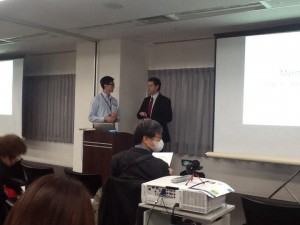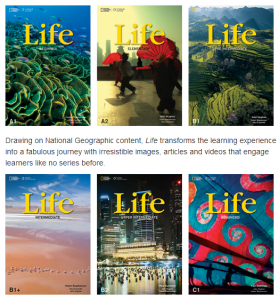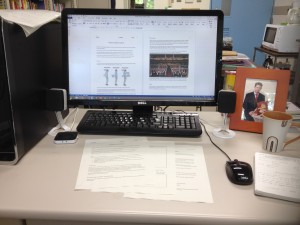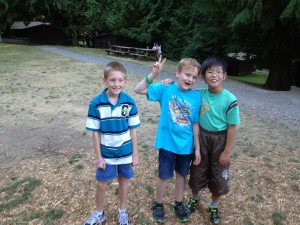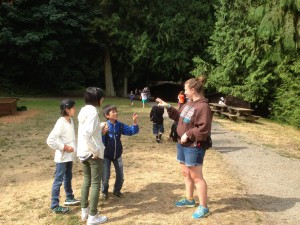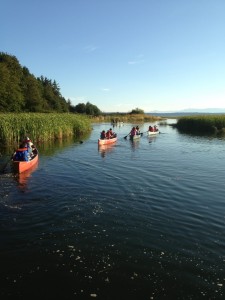conference curriculum elllo extensive listening extensive reading graded readers language courses Language learning materials online resources presentations self-study
by sendaiben
2 comments
Oxford Day 2013 video, slides, and writeup
I was extremely lucky to be invited to speak at the first Oxford Day in Japan this month.
I wasn’t really sure what to expect, but I really enjoyed the whole thing. 188 teachers attended, and there were nine presentations (five time slots). The venue was a very comfortable meeting space in Shibuya, and the provided coffee and sandwiches were excellent.
Most importantly for me, I had a fantastic group of teachers in my presentation who were very forgiving and asked me a bunch of questions at the end. Here is a copy of my slides in .pdf format and the video of the presentation is below:
131123 Maximising Input (slides in .pdf format)
If you have any questions please let me know in the comments, or send me an email to sendaiben@gmail.com.
language courses materials Review reviews textbooks
by sendaiben
leave a comment
Review: Life (4-skills series by Cengage)
After a long hiatus, a review. This textbook is for teenagers and adults.
Life is a 6-level, 4-skills series consisting of a student book, workbook, and teacher’s book at each level. The student book has a DVD with videos, and the teacher’s book contains two CDs with the class audio. The workbook also has a CD for listening-based homework. The series runs from Beginner (A1) to Advanced (C1).
First impression: Life is gorgeous. Cengage is really leveraging all those National Geographic photos they have access to, and it is working really well. If you are a Japan-based teacher you will probably be struck by how dense the book is -there is a lot on each page and much less white space than we are used to. Someone described it as a ‘European-style’ textbook, as opposed to ‘Asian-style’.
The Good
- This is a very attractive textbook. The design and production values are very high.
- There is a lot of content. Each book has 12 units, each unit has 6 sections. We’ve been working through one section per class so far.
- A really nice variety of topics and media (print. audio, video).
- There is a lot of variety. Reading, grammar, vocabulary, and speaking exercises on almost every page.
- The class audio is included in the teacher book. I like this idea a lot, rather than making us buy separate overpriced classroom CDs like many publishers do.
- The website actually seems to have useful materials on it 🙂
The Bad
- It’s expensive. All those production values come at a cost (EDIT: but there is a split edition I haven’t seen that incorporates half of the student book and workbook together).
- For Japanese students, it’s completely unbalanced. The grammar parts are way too easy, the reading/listening are too difficult.
- The dense page layouts can be intimidating (just a first impression problem).
Overall
I really like the series so far. We’re three weeks in and the students like it and are challenged by it, and it’s a fairly intuitive textbook from the teacher’s point of view. We’ve been using the Intermediate level with our ‘advanced’ high school student eikaiwa class, so I’m looking forward to using some of the other levels in due course. Recommended.
curriculum expectations language courses materials presentations publishing textbooks university
by sendaiben
leave a comment
Creating new teaching material
This semester I am working on a new presentation textbook for my classes here at Tohoku University (okay, so I am also hoping I will be able to sell it to a publisher eventually too), and thought it might be interesting to write a little about how that is turning out. Experienced material developers probably won’t get much out of this, but if you are just starting out like I am, or have yet to start, you might find something useful.
My desk at work. Note the all-important coffee cup and blank notebook -I find it really helpful to explore ideas on paper before starting work on the computer.
For my presentation course, I was provided with some fairly rigid constraints: too many students (one class of 32 and one of 25), too few classes (maximum of 14, more like 13 once the first one is used up for orientation), and a not-quite perfect classroom (it’s a little too small for group work). However, this is actually helpful, as it provides space in which to work. Having complete free reign paralyses me.
My project is very much a work in progress at the moment, but here are the major steps so far:
- determine the goals of the course
- decide on topics to include, and the order to teach them in
- establish a class routine
- figure out what materials to create for each class
- write the materials
- scribble over the materials in red pen after class with corrections and ideas
I have realised those four elements in bold are the foundation of a class, and getting them straight is probably 90% of the work. Now that they are done, and in great contrast to previous courses I have designed, it’s pretty easy to sit down each week and plan my classes.
Right now I am mainly trying to get the content and the activities right, and not worrying too much about design.
Has anyone successfully completed a project like this? Am I missing anything?
business curriculum eikaiwa ES expectations JHS junior high school kids language courses Language learning overseas study trips school management summer camp young learners
by sendaiben
2 comments
Taking students to summer camp in the US
This is a guest post (the first on this blog!) by a friend of mine, Ryan Hagglund. He has an extremely promising variation on the usual study abroad trip that I thought you would find interesting. Enjoy and let us know what you think in the comments.
After many years of thinking about it, we finally took students from our school (MY English School in Yamagata) to the US for the first time this summer. Thanks to all the advice and stories I read and heard from others, the trip was overall a success and will hopefully serve as a building block for many more to come.
My impression is that most international trips English schools organize involve some form of formal study. While there is obviously nothing wrong with studying—we ARE a language school—it seems like there’s plenty of time for the students to study while in Japan. The main purpose for us in going was to give the students something they couldn’t receive here: the opportunity to interact with large numbers of English-speaking children of their own age. We wanted to give them an experience that would lead to greater motivation and increased interaction skills, among other things. The instrument we chose to accomplish this was to have the children attend a summer camp intended for children who are native speakers of English, not English learners.
We chose Warm Beach Camp in Stanwood, Washington. We chose Warm Beach for several reasons. First, it is the camp I attended when an elementary and JHS student, so I was familiar with the facilities. Having attended almost 30 years ago, however, I no longer had connections to any of the staff. Second, it is a large facility that not only has many activities for campers to do, but was also able to house our staff away from our students but still onsite. Third, it gave considerable value for the price. Camp was only US $399 per student for six days and five nights—including meals—and they supplied free room and board for our staff in a separate onsite facility. They also provided free sleeping bags and pillows to our students. (Warm Beach is a Christian camp facility, but we were careful to make sure our students and their parents were aware of this. There are most likely secular camps with similar facilities and value.)
We took five students—two boys and three girls—ages 9-13 (Japanese elementary 4th grade to JHS 2nd year). There were approximately 80 campers all together ages 9-11 (US 4th to 6th grade) divided into cabins of six or seven students each. Our 13-year-old student had no problems relating to the younger campers, though JHS 1st year would probably be a good cutoff. Since none of the US campers nor counselors spoke Japanese, the students had to navigate in English. What was nice, however, were the many activities the children were able to participate in, allowing them to interact in English without consciously having to overly focus on the language itself. Some of the activities they participated in were: field games, swimming, archery, horseback riding, canoeing, wall climbing, BB-gun shooting, mini-golf, and a bonfire. While it was challenging for them at first, by the end of the trip four of the five students said they would like to stay longer. The fifth (12 years old) said she was glad to have come, but just ready to go home. We were only with the students for a daily meeting each evening, when pre-activity safety instructions in Japanese were necessary, and when a student became homesick and needed a little extra support. We had a pre-paid US cell phone so the camp and/or counselors could reach us at any time if necessary. They only called us once.
While the camp was our focus, we did do other activities as well. Our schedule was as follows:
Saturday Aug 3 – Arrive in Seattle and tour the city
Sunday Aug 4 – Visit Wild Waves Theme Park
Monday Aug 5 – Saturday Aug 10 – Attend camp and Seattle Mariners baseball game (Aug 10)
Sunday Aug 11 – Return to Japan
We will probably add an additional day of Seattle sightseeing if we go again next year.
Camp positives:
1) No need to be concerned about the quality of homestay families.
2) No need to worry about logistics for most of the trip. While at the camp, we were able to focus entirely on the students’ linguistic and emotional needs, while enjoying ourselves for most of the time. The camp took care of the rest.
3) No need to think of specific language activities, as the situation itself required meaningful English interaction from our students.
4) The camp wanted the trip to be successful as much as we did.
5) No need to pay a third party for special arrangements.
6) Students needed very little spending money. Each student brought 20,000 yen in spending money, but none of them came close to using it all.
7) Since almost everything was included in the camp price, there were fewer opportunities for financial surprises.
8) 24-hour onsite certified nurse, removing the need for us to worry about student sickness and/or injury.
Camp possible negatives:
1) We did have to plan the logistics outside of camp time. This included airline booking, three nights of hotel, sightseeing in Seattle, and transportation to and from the camp. While not difficult, might be hard to leave to a school teacher or staff member not familiar with the Seattle area.
2) Not as appropriate for students who would prefer a “travel experience” versus an “immersion experience”.
All in all, it was a very successful trip—especially for a first time. We are already working to produce marketing materials for a similar trip next year.
Ryan Hagglund is President and CEO of MY English School in Yamagata Prefecture. He has lived in Japan for 15 years and originally hails from the Pacific Northwest. He is married to Maki Hagglund and has three children: Aiden (8), Ian (6), and Sean (4).
business EFL eikaiwa ES expectations high school JHS junior high school kids language courses Language learning school management SHS study trips travel young learners
by sendaiben
17 comments
Taking Students Overseas
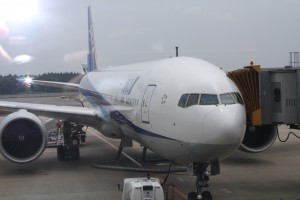
I just returned from our second overseas study trip with young learners. It was one of the most exhausting things I have ever done, and involved a large amount of stress for a relatively small return.
Taking students overseas can be a very positive activity for an eikaiwa school:
1. It can be profitable
2. It can raise the school’s profile and image
3. It can be hugely beneficial to student motivation
However, there are also huge potential risks:
1. Worst case scenarios are really bad, and could prove fatal to the school
2. It can involve a huge amount of supplementary work
3. Unexpected expenses can eat up your profit and even push the trip into the red
After two ‘successful’ (I define successful as not having encountered any serious problems) trips, I have learned a huge amount about what doesn’t work. The next two posts will be detailed trip reports and reflections.
Does anyone else organize overseas trips?
